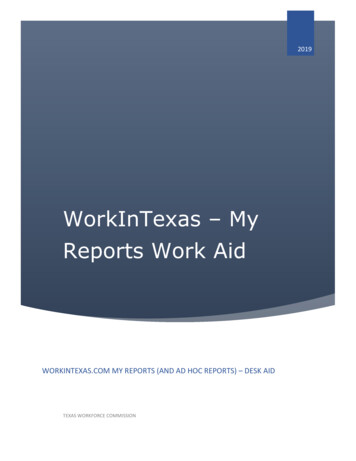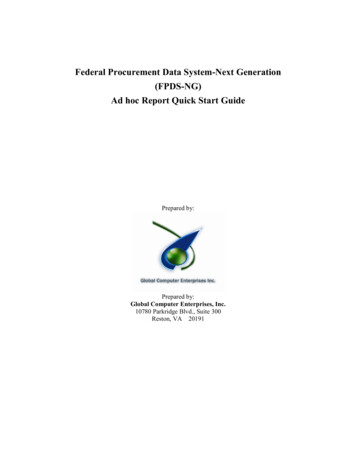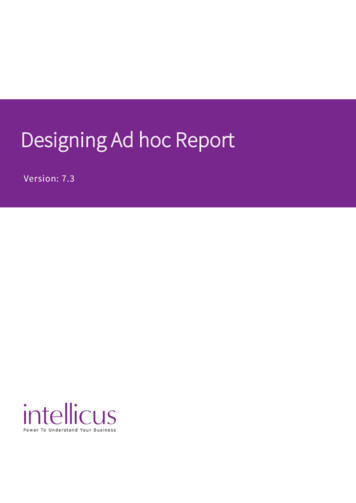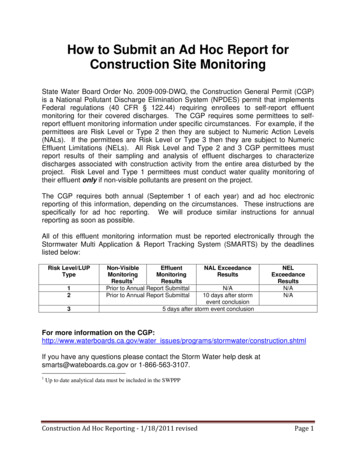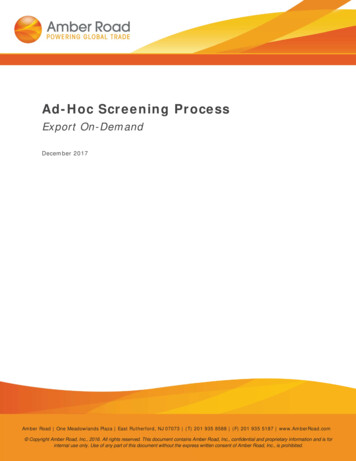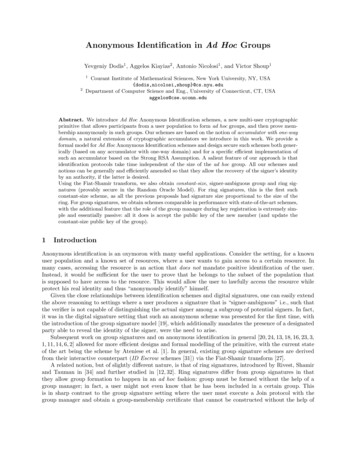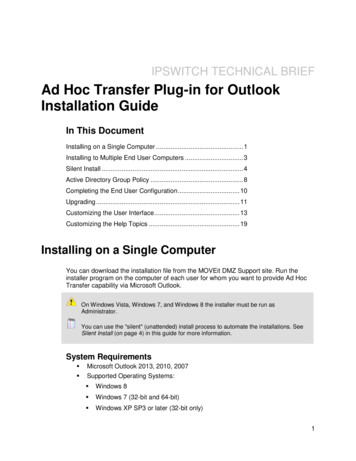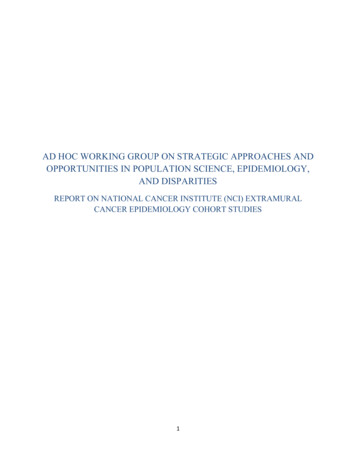
Transcription
AD HOC WORKING GROUP ON STRATEGIC APPROACHES ANDOPPORTUNITIES IN POPULATION SCIENCE, EPIDEMIOLOGY,AND DISPARITIESREPORT ON NATIONAL CANCER INSTITUTE (NCI) EXTRAMURALCANCER EPIDEMIOLOGY COHORT STUDIES1
TABLE OF CONTENTSWorking Group Roster3Executive Summary5Overview of Observational Cohorts within the NCI Extramural Research Portfolio11Working Group Question Report NarrativesQuestion 1: The role of cohort studies in etiologic and survivorship research inhuman populationsQuestion 2: Utility of cohorts for addressing cancer health disparitiesQuestion 3: Study design considerations for extramural cancer epidemiology riskand survivor cohortsQuestion 4: Data sharing and collaborationQuestion 5: Funding models for cohorts1422263033List of FiguresFigure 1A. Projections for incidence of selected cancer types to the year 2030Figure 1B. Projections for mortality of selected cancer types to the year 2030Figure 2. Estimated cancer prevalence by age in the U.S. population from 1975 to2040Figure 3. Race and ethnicity of participants in NCI extramural cohorts16161723Appendix I: TablesTable 1. Extramural epidemiology cohorts currently supported by NCITable 2. Number of study participants by race and ethnic group – risk cohortsTable 3. Number of study participants by race and ethnic group – survivor cohortsTable 4. Cancer sites reported in risk and survivor cohortsTable 5. Number and type of biospecimens available from risk and survivor cohorts3739404141Appendix II: List of Expert Presentations to the Working Group43Appendix III: Description of Major U.S. Cancer Epidemiology Cohorts NOTSupported by the NCI Extramural Program43References462
Working Group RosterNATIONAL INSTITUTES OF HEALTHNational Cancer InstituteNational Cancer Advisory BoardAd Hoc Working Group on Strategic Approaches and Opportunities inPopulation Science, Epidemiology, and DisparitiesCO-CHAIRJulie R. Palmer, Sc.D.Karin Grunebaum Professor of CancerResearchBoston University School of MedicineAssociate DirectorSlone Epidemiology CenterCo-DirectorBU-BMC Cancer CenterBoston, MassachusettsCO-CHAIRLeslie L. Robison, Ph.D.Chair, Department of Epidemiology andCancer ControlAssociate DirectorCancer Prevention and ControlComprehensive Cancer CenterCo-Leader, Cancer Control andSurvivorship ProgramSt. Jude Children's Research HospitalMemphis, TennesseeMEMBERSLucile L. Adams-Campbell, Ph.D.Professor of OncologyAssociate DirectorMinority Health and Health DisparitiesResearchSenior Associate DeanCommunity Outreach & EngagementLombardi Comprehensive Cancer CenterGeorgetown University Medical CenterWashington, D.C.Christine Ambrosone, Ph.D.Professor of OncologySenior Vice President, Population SciencesChair, Cancer Prevention and ControlRoswell Park Alliance Foundation EndowedChair in Cancer PreventionRoswell Park Comprehensive Cancer CenterBuffalo, New YorkJames R. Cerhan, M.D., Ph.D.Professor of EpidemiologyChairDepartment of Health Sciences ResearchMayo Clinic College of Medicine andScienceRochester, Minnesota3
Judy E. Garber, M.D., M.P.H.DirectorCenter for Cancer Genetics and PreventionDana-Farber Cancer InstituteProfessor of MedicineHarvard Medical SchoolBoston, MassachusettsBruce D. Rapkin, Ph.D.ProfessorDepartment of Family and Social MedicineHead, Division of Community Collaborationand Implementation SciencesDepartment of Epidemiology and PopulationHealthAlbert Einstein College of MedicineBronx, New YorkMaria Elena Martinez, Ph.D. M.P.H.ProfessorDepartment of Family Medicineand Public HealthAssociate Director, Population Sciences,Disparities, and Community EngagementMoores Cancer CenterUniversity of California, San DiegoLa Jolla, CaliforniaMargaret R. Spitz, M.D., M.P.H.ProfessorDepartment of MedicineDan L. Duncan Cancer CenterBaylor College of MedicineHouston, TexasKate Yeager, Ph.D., R.N.Research Assistant ProfessorNell Hodgson Woodruff School of NursingEmory UniversityAtlanta, GeorgiaElectra D. Paskett, Ph.D.Marion N. Rowley Professor of CancerResearchDirector, Division of Cancer Preventionand ControlDepartment of Internal MedicineCollege of MedicineThe Ohio State UniversityColumbus, OhioExecutive SecretaryDeborah M. Winn, Ph.D.Acting DirectorDivision of Cancer PreventionNational Cancer InstituteNational Institutes of Health4
NCAB WORKING GROUP REPORT: NCI EXTRAMURAL CANCER EPIDEMIOLOGY COHORT STUDIESExecutive SummaryAt its November 2017 meeting, the National Cancer Advisory Board (NCAB) of NCI voted tocreate an ad hoc Working Group on Strategic Approaches and Opportunities in PopulationScience, Epidemiology, and Disparities. The Working Group, established in May 2018, wascharged by NCI Director Ned Sharpless to first develop recommendations regarding how theobservational extramurally supported cancer epidemiology cohort program can be enhancedgoing forward.In consultation with NCI, the Working Group identified five questions to focus on that wouldcapture key issues related to the extramurally supported cancer epidemiology cohort program.The group met by teleconference on nine occasions for discussion and background briefingsprovided by experts (listed in Appendix II). This was followed by an in-person meeting ofWorking Group members on January 24-25, 2019, and two more teleconferences to discussdrafting the report. The five key questions are outlined below.Question 1. The role of cohort studies in etiologic and survivorship research inhuman populationsHow can NCI ensure that its cancer epidemiology cohort portfolio has the potential toaddress questions of the future related to cancer risk, cancer recurrence, cancer survival,and cancer-related long-term health outcomes?Question 2. Utility of cohorts for addressing cancer health disparitiesWhat is the best way to ensure that the portfolio of extramural cohorts includes cohortswith large numbers of one or more populations that have been understudied andunderserved?Question 3. Study design considerations for extramural cancer epidemiology riskand survivor cohortsWhat are the optimal study designs to address cancer risk, recurrence, survival, and longterm health-related outcomes following cancer in human populations?Question 4. Data sharing and collaborationHow can NCI ensure that the extramural scientists responsible for designing, organizing,and maintaining the cancer epidemiology cohorts remain motivated to continue thesetime-consuming efforts in this era of rapid sharing of data?Question 5. Funding models for cohorts5
NCAB WORKING GROUP REPORT: NCI EXTRAMURAL CANCER EPIDEMIOLOGY COHORT STUDIESIs the funding mechanism to support cancer epidemiology cohorts optimal? If not, whatother models might be better?Based on careful analysis and the consideration of a range of options, the NCAB Working Groupon Strategic Approaches and Opportunities in Population Science, Epidemiology, and Disparitiesrecommends that NCI move to implement the following recommendations. Eachrecommendation is justified and discussed in detail in the Working Group Question ReportNarratives section.Recommendations for Question 1: The role of cohort studies in etiologic and survivorshipresearch in human populations1. There will inevitably be circumstances where a cohort design reflects the mostscientifically rigorous approach, and generally the most cost-effective approach over thelong term, to investigate important existing and emerging topics relating to cancer riskand outcomes. Thus, NCI should invest in providing sufficient infrastructure support forcohorts to conduct or facilitate research that addresses critical scientific gaps, anticipatesthe scientific questions of the future, and considers societal issues that are deemed to beof high importance with high impact.2. While capitalizing when possible on existing or planned major cohorts such as All ofUsSM or NCI’s Division of Cancer Epidemiology and Genetics (DCEG) Connect Cohort,NCI should continue to support new and existing focused cohort studies to addressspecific cancer etiology and survivorship questions.3. NCI should promote or facilitate the use of existing and planned intramural cohorts inorder to leverage access of these resources for the broader extramural community toconduct research that will inform determinants of cancer risk and health outcomes after acancer diagnosis.4. Cancer survivorship cohorts should be designed to facilitate research that spans theperiod from diagnosis to long-term survival. This may best be achieved by leveragingdata available through clinical trials. In the future, electronic medical records may be anexcellent source of data for such cohorts, but at present the quality of data available is notadequate, due to incompleteness, limitations of natural language processing, and limitedinteroperability across records.5. When considering the establishment of new survivor cohorts, opportunities to leveragethe patient populations available through the NCI-supported cooperative clinical trialsgroups and the NCI Community Oncology Research Program (NCORP) should be givenstrong consideration. NCI should support the conduct of pilot studies to determine thefeasibility and design for establishing an adult survivor cohort to investigate treatmentrelated adverse outcomes for cancer patients enrolled and not enrolled in a clinical trial.A challenge that must be addressed is collecting adverse outcome data at the same levelof detail for those not enrolled in clinical trials.6
NCAB WORKING GROUP REPORT: NCI EXTRAMURAL CANCER EPIDEMIOLOGY COHORT STUDIES6. NCI should promote or facilitate the use of prevention and cancer therapy trials toaddress etiological and survivorship questions after they have met their primary andsecondary endpoints. Whenever possible, this should include planning at the beginning ofprevention and therapy trials to follow-up with study participants and collect data usefulfor addressing both etiologic and survival questions and trial-related scientific questionsrequiring long-term follow-up. It will be critical to involve observational cohortinvestigators and prevention and therapy trial researchers in enhancing the capacity ofcancer prevention treatment trials to collect more and detailed data that will be useful inevaluating the long-term cancer risks, second primary cancers, and other health eventsoccurring subsequent to the end of the trial. Enhanced informed consent documents willalso be required.7. To facilitate cohort-based research, NCI should support establishment of nationalinfrastructure for ascertainment and follow-up of cancer cases (i.e., the Virtual PooledRegistry’s and the Surveillance, Epidemiology, and End Results [SEER] program’sability to fully characterize treatment exposures).8. More exploration of the opportunities for research on biomarkers of early detection incohort studies is needed.9. NCI should support methodological research to evaluate the risks, benefits, and optimumapproaches for the return of results to cohort participants.10. As part of the ongoing peer-review process for continued funding of cohorts,investigators should be asked to justify the need for continued follow-up of the membersof the cohort, including the anticipated scientific yield. The study section peer-reviewprocedures should include an assessment of the investigators’ justification. When theyield from a cohort is deemed to no longer be justified, then consideration should begiven to transitioning a cohort to passive follow-up (i.e., linkage with vital statistics) ortermination.11. There are important opportunities to draw upon the strengths/attributes of cohorts toconduct intervention research by (1) identifying opportunities within existing cohorts forthe conduct of intervention-based research that would not compromise the primaryobjectives being addressed within the cohort, and (2) considering study design andinfrastructure requirements for future cohorts to maximize opportunities to integrate orfacilitate intervention-based research.Recommendations for Question 2: Utility of cohorts for addressing cancer health disparities1. Additional cohorts are required in order to fill existing and future gaps in the NCI cohortportfolio with regard to research on underrepresented populations. The goal is to ensurethat detailed study of the determinants of risk and cancer outcomes in these populationscan be ascertained with high statistical precision. The Working Group identified thefollowing as of highest priority for additional funded cohorts: Hispanics in the U.S.;7
NCAB WORKING GROUP REPORT: NCI EXTRAMURAL CANCER EPIDEMIOLOGY COHORT STUDIES2.3.4.5.6.Pacific Islanders; American Indians/Alaska Natives; Blacks; persons of lowsocioeconomic status; and residents of rural Appalachia.Only one cohort includes a sizable number of Hispanics, Pacific Islanders, and Blacks,and the current age range in that cohort is now 71-99. Two other cohorts include largenumbers of Black participants, but they too are aging. While the accumulated resourcesfrom cohorts that “age out” can be archived for future work, research on cancer in morerecent birth cohorts of participants from underrepresented groups will be required inorder to study the effects of new or evolving exposures and social conditions.Support additional biospecimen collection (tumor tissue and blood are the highestpriorities) in those existing cohorts that have an appreciable number of participants froma single underrepresented group in an appropriate age range to address scientificallyimportant questions.Encourage risk and survivor cohorts to include questions that permit participants to selfidentify as sexual and gender minorities (SGM).Provide investigator-initiated funding (e.g., R01 or P01) to conduct multi-cohortcollaborative research addressing compelling scientific questions among minorityparticipants with less common cancers such as head and neck, pancreas, kidney, andmyeloma, and on specific subtypes of other cancers.It is not necessary for cohort studies to represent all, or even several, race/ethnicitypopulations. The major goal is to ensure that currently underrepresented groups berepresented in sufficient numbers across the entire NCI cohort portfolio to allow formeaningful within-group analyses. Comparisons across population groups is a secondarygoal, which can be accomplished in a variety of ways, including comparisons with othercohorts or the published literature. New cohorts can address the major goal throughdifferent approaches, including studies of single population groups and studies ofmultiple groups that oversample minority groups. Future program announcements shouldnote that cohorts of single populations are acceptable.Recommendations for Question 3: Study design considerations for extramural cancerepidemiology risk and survivor cohorts1. Cohorts remain a major investment in cancer epidemiology, but also provide some of thegreatest scientific impact, and thus ensuring a balanced portfolio of cancer risk andsurvivor cohorts is important. Etiology cohorts should consider the current or emerginggaps in research and comprise the appropriate populations (age, birth cohorts, and criticalwindows of exposure) to address the gaps. New survivor cohorts should address currentand emerging research gaps by cancer type and/or treatment.2. Approaches for leveraging innovative sampling frames to recruit study participantsshould be utilized to maximize the value of cohorts in addressing scientific questions.3. There is a need to promote improvements in electronic health records (EHR) systems andother digital technologies to enable them to be better utilized as sampling frames, and for8
NCAB WORKING GROUP REPORT: NCI EXTRAMURAL CANCER EPIDEMIOLOGY COHORT STUDIES4.5.6.7.8.9.exposure assessment and ascertainment of outcomes for cancer etiology and survivorstudies.NCI should identify possible opportunities for embedding cohorts in intervention trialsfor primary prevention, screening and treatment. Further, NCI should consider joiningwith other NIH institutes in creating cohorts that could address both cancer outcomes andother health outcomes.Given limited resources, cohorts should generally derive their study populations from theU.S. and its territories. Nevertheless, there may be circumstances where a studypopulation from another country provides unique opportunities that should be pursuedwhen possible.The Working Group strongly encourages, when scientifically justified, the incorporationof serial data and biologic specimen collection cycles over extended periods of time toreduce measurement error for time-dependent events (e.g., quitting smoking) and toenable a better understanding of the natural history of cancer (e.g., how epigenetic ormetabolomic or immunological characteristics change over time and influence cancer riskand outcomes).There is a need to adopt innovative methods for data collection from study participants,when appropriate, that may be more accurate, less burdensome, and economical toadminister (e.g., mobile technologies).Consideration should be given to study participant preferences (interview vs.questionnaire), abilities (electronic devices), and environmental context (internet access)for providing their data. Innovative and validated approaches should be utilized tomaintain bi-directional engagement of cohort participants with the researcher team.The NCI should support or facilitate methodological research to identify efficient andeffective approaches for incorporation of longitudinal specimen and data collection intocohort studies.Recommendations for Question 4: Data sharing and collaboration1. Guidelines and/or mandates for data sharing of cohort-based data must take intoconsideration the investment of time and academic implications for the investigatorsresponsible for establishing and maintaining the cohort. Thus, these investigators shouldhave a defined window of opportunity to pursue their own research interests within thecohort, prior to making the data available to the broader research community.2. Given the investigator and staff time/effort associated with data sharing/collaborativeefforts (initial posting and updating of data, subsequent updating of data and associateddocumentation, review of concept proposals, preparation of user-friendly data files andassociated documentation, and responding to questions) ongoing funding for data sharingwill be needed. Supplements have not been an appropriate funding approach for thesepurposes because of the limited timeline for activities.9
NCAB WORKING GROUP REPORT: NCI EXTRAMURAL CANCER EPIDEMIOLOGY COHORT STUDIES3. For existing cohorts, data sharing guidelines should allow for different mechanisms ofsharing depending on requirements of the informed consents provided by the cohortparticipants. In some cases, informed consents may not allow for some types of sharing(e.g., placing individual-level data in a government database that can be accessed byoutside investigators without oversight by the cohort investigators), and it may notalways be feasible to re-consent participants.4. For new cohort studies, consent for broad data sharing should be made part of the initialenrollment procedure.5. Given NCI’s investment in data science and the availability of new tools and technology,NCI should invest in the modernization of existing and new cohorts to facilitate sharing,with practices consistent with FAIR (Findable, Accessible, Interoperable, Reusable)principles.6. If there is an initiative for creation of a centralized data sharing platform(s) for cohortbased data, it should be recognized that, because of the heterogeneity of study designsand associated data elements, it would have to be limited to the set of variables commonto the majority of cohorts. This limited set of common variables would likely not meetthe needs of many researchers. An alternative could be development of a federatedsystem in which each study has its own data platform, which can be accessed, withappropriate permissions and informed consents, to pull data elements across cohorts.Recommendations for Question 5: Funding models for cohorts1. The NCI should continue to use a Cohort Infrastructure Program Announcement forfunding infrastructure activities of cancer cohorts. Investigator-initiated hypothesisdriven research based on cohort data would continue to be funded through R grants, P01s,and related mechanisms.2. Applications for new cohorts should be considered in a special study section, separatefrom the study section that reviews continuations of cohorts.3. It may be most effective for the NCI to accept applications for new cohorts only inresponse to a call for applications, which would occur periodically as needed.4. Decisions about when to stop funding active follow-up of a given cohort should be madebased on the likely productivity and importance of findings that will occur over the nextfive years.5. A specific subheading could be added to the cohort infrastructure application to ensurethat PIs will give a detailed rationale and justification for continuation of the cohort foranother five years.6. There is a need for further discussion to determine best practices for whether and howsamples should be preserved for future use after funding for a given cohort has ceased, aswell as who will make decisions about biospecimen use. At a minimum there is a cost forkeeping freezers operating and supporting sample management.10
NCAB WORKING GROUP REPORT: NCI EXTRAMURAL CANCER EPIDEMIOLOGY COHORT STUDIESOverview of Observational Cohorts within the NCI Extramural Research PortfolioThe extramural program of the NCI currently supports numerous large observational cancerepidemiology cohorts to study determinants of cancer in human populations and health outcomesamong cancer survivors. The cohort study remains one of the strongest sources for evaluatingrisk of cancer as well as cancer outcomes, including treatment effectiveness. In many settingsthis is the only practically and/or ethically available source of evidence for clinical and publichealth decisions and is now being considered by FDA in certain situations to assess efficacy aspart of their Real World Framework (U.S. FDA, 2019). Thus, cohort studies have been and willcontinue to be a fundamental and key resource for generating and evaluating new knowledgeacross the cancer continuum.The design, conduct, and maintenance of cohorts addressing cancer etiology and outcomes aresupported through a variety of grant funding mechanisms from NCI. An examination of thecurrent NCI portfolio of extramurally-funded cancer cohorts found that: NCI supports 20 risk cohorts, for which the outcome studied is incident cancer, and 10survivor cohorts, with outcomes of long-term morbidity and mortality (listed in AppendixI, Table 1).The number of study participants overall and by race and ethnic group across the riskcohorts is shown in Table 2 for risk cohorts and Table 3 for survivor cohorts. Overall,more than 2.8 million U.S. domestic study participants are being followed for the riskcohorts and 86,000 for the survivor cohorts. Of the 2.9 million, 1.4 million are in theBreast Cancer Surveillance Consortium, a breast cancer screened population.The most common cancers being investigated in the cohorts (Table 4) reflects the mostcommon cancers in the U.S. population, with breast, prostate, lung, and colon canceraccounting for 78% of all incident cancers across the cohorts to date.Most of the cohorts collect biospecimens, including blood, urine, and tumor tissues.Some collect saliva or buccal cells in addition to or in lieu of blood. Two cohortscollected feces. The counts of biospecimens by cohort by type of biospecimen is shownin Table 5.The currently funded risk cohort with the longest duration of follow-up is the Nurses’Health Study, which began enrollment in 1979.The Southern Community Cohort Study is the most recently established risk cohort in thegrant portfolio; it started enrolling study participants in 2002 and completed enrollment in2009.Information about the racial and ethnic groups and study participants from understudieddemographic groups are described in the section of this report on health disparities. Informationabout many of these cohort research resources is available in the Cancer EpidemiologyDescriptive Cohort Database (CEDCD: https://cedcd.nci.nih.gov/).11
NCAB WORKING GROUP REPORT: NCI EXTRAMURAL CANCER EPIDEMIOLOGY COHORT STUDIESNCI funds its extramural cohort portfolio using grants mechanisms. All but one of these grantsare managed either by the Epidemiology and Genomics Research Program (EGRP) in theDivision of Cancer Control and Population Sciences or by the Division of Cancer Prevention (forseveral of the cohorts that were generated from cancer prevention trials). The current annual totalcost (direct plus indirect costs) as of April 30, 2019 was 34 million for the risk cohorts (Table1). For the survivor cohorts the amount was 22 million.Because cancer epidemiology cohorts are viewed as research resources, NCI expects cohortprincipal investigators to share data and biospecimens with other researchers. The CEDCDprovides information about how researchers can access the data and specimens from many ofthese cohorts. The current NCI announcement (PAR-17-233) for support of core infrastructureand methodological research for cancer epidemiology cohorts includes the following datasharing policy:Individuals are required to comply with the instructions for the Resource Sharing Plans asprovided in the SF424 (R&R) Application Guide, with the following modification:NCI expects awardees to propose and implement a robust data sharing plan that details howexternal investigators gain access to data and biospecimens to ensure that this resource isused widely. Individuals are required to comply with the instructions for the ResourceSharing Plans as provided in the SF424 (R&R) Application Guide, with the followingmodification:oooAll applications, regardless of the amount of direct costs requested for any one yearare expected to include a Data Sharing Plan that is compliant with NIH data sharingpolicies, including the NIH Genomic Data Sharing Policy(https://gds.nih.gov/03policy2.html).CECs are required to maintain a website that details the procedure for requestingand obtaining data for external Investigators as appropriate and consistent withachieving the goals of the program. A summary of the number of data requests,acceptances, and rejections should be provided in annual progress reports to NCI.Awardees are strongly encouraged to deposit individual-level de-identified datasetsto NCI’s centralized, controlled-access database, called the Cancer EpidemiologyData Repository (CEDR). More information about this resource is available athttps://epi.grants.cancer.gov/CEDR.Most of the risk cohorts are members of the NCI Cohort /cohort.html), which enables investigators to pool cohortdata to conduct studies where there are not adequate numbers of participants for investigation ofrarer cancers, molecular subtypes of common cancers, rare exposures, and smaller demographicstrata among other factors. The Cohort Consortium and the willingness of principal investigatorsof large cancer epidemiology cohort studies to pool data and analyze DNA from studyparticipants have played an important role in the conduct of genome-wide association studies ofnumerous types of cancer.12
NCAB WORKING GROUP REPORT: NCI EXTRAMURAL CANCER EPIDEMIOLOGY COHORT STUDIESWhat is not covered in this report. This report does not cover specialized risk cohorts whosestudy participants may have been ascertained because of a characteristic such being HIV-positiveor exposure because they work in a specific industry. It does not include cohorts that NCI mayfund in other countries for specific purposes such as to investigate populations with very highrisks of particular cancers or unusual exposures. This report does not cover all aspects of cancersurvivorship, but rather focuses primarily on the outcomes of mortality and survival, recurrenceof the primary cancer, incidence of new primaries, and certain other physical sequelae. It isrecognized that many cancer survivor cohorts collect a wider scope of content domains,including adverse sequelae after a cancer diagnosis, psychosocial concerns, health-related qualityof life, health behaviors, patterns of care, and the economic impact of cancer. While these otherdomains are important topics for study and cohorts that include these domains are of highscientific, clinical, and psychosocial value, developing recommendations on these other domainsfell outside of the scope of this report.13
NCAB WORKING GROUP REPORT: NCI EXTRAMURAL CANCER EPIDEMIOLOGY COHORT STUDIESWorking Group Question Report NarrativesQuestion 1. The role of cohort studies in etiologic and survivorship research in humanpopulationsBackgroundA robust and scientifically rigorous portfolio of research addressing the etiology and outcomes ofthe more than 1.7 million new cancer cases diagnosed each year in the U.S. (Siegel et al., 2019)is important to the mission of NCI. Projections of cancer incidence and mortality, taking intoconsideration changes in the demographics of the U.S. population (Figure 1), emphasize thedynamic landscape and impact of cancer within the population (Rahib et al., 2014). Moreover,with the improvements in cancer detection, diagnosis, and treatment, it is estimated that therewill be 18.1 million cancer survivors in the U.S. by 2020 and this is projected to increase by31%, to 20.3 million, by 2026 (Bluethmann, et al., 2016) (Figure 2).In addition to the heterogeneity of cancer within and across types, the documented differences incancer incidence, mortality, and long-term outcomes by factors such as sex, age, race/ethnicity,and socioeconomic status highlight the complexities of cancer research. Observational cancerresearch has contributed significantly to the underst
10. As part of the ongoing peer-review process for continued funding of cohorts, investigators should be asked to justify the need for continued follow-up of the members of the cohort, including the anticipated scientific yield. The study section peer-review procedures should include an assessment of the investigators' justification. When the

